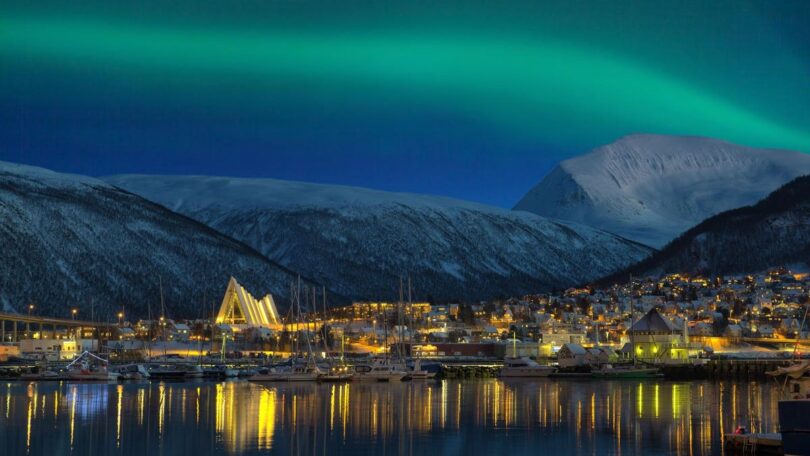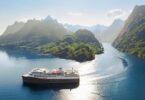The season has barely started but already aurora hunters in Norway have been treated to some spectacular northern lights in the night sky. With the news that we’re at the peak of the sun activity cycle spreading fast, many travelers are planning a trip to Scandinavia this winter with the hope of seeing the aurora for themselves.
The northern lights above the landmark Arctic Cathedral in Tromsø, Northern Norway.
Of course, there’s no guarantee of seeing the northern lights no matter where or when you go, or what the tour guides promise you. However, making smart travel planning decisions can significantly increase your chances.
These include the time of year (mid-September to early November and February to early April are generally considered the peak times) and also the location.
Northern Norway is an attractive location as much of it lies immediately below the aurora oval, which means you can see the lights even when the aurora forecast is relatively weak.
The best places to see the northern lights
The basic requirements for a successful northern lights hunt are simple. You need total darkness and a clear sky. Some factors to consider here are that some coastal areas are prone to thick cloud cover, while built-up areas can leak a lot of ambient light even if you get away from the city.
It’s also important to consider your vacation as a whole. A northern lights sighting may be the goal, but plan other fun activities into the daytime and you’ll turn a good trip into a great one. If you’re unlucky and the lights don’t come out to play, you’ll at least leave Northern Norway with some good memories.
So, while it’s absolutely a good idea to get as far north as possible, you should also choose a destination with plenty of other things to do especially during the day. That’s exactly why Tromsø and Alta are the two places you’ll find recommended more than any other.
Tromsø
The biggest city in Northern Norway tops the list of northern lights destinations for many reasons. Many tour operators compete for your business, with some promising to drive guests for several hours to find clear skies.
For a DIY approach, take the local bus to the northern side of Tromsø island or up to the small lake Prestvannet at the top of the island.
However, the real reason to choose Tromsø is to guarantee an enjoyable break regardless of your success in the evenings. Highlights on a visit to Tromsø include the polar museum, the Polaria aquarium, the family-friendly science center, and the iconic Arctic Cathedral.
Take the Fjellheisen cable car up to the mountain that overlooks the city to gain a fantastic perspective on the city and its surroundings. When bathed in the deep indigo light of the ‘blue hour’, the view seems truly surreal. Just be sure to wrap up warm, as the wind up there can be bone-chilling.
Alta
The major alternative to Tromsø in the high north is Alta. Although a much smaller city, it’s still got everything you need for a comfortable stay.
An aurora display behind the Northern Lights Cathedral in Alta, Norway.
While Alta is also on a fjord, it is located farther inland than Tromsø, so (in theory at least) should offer clearer skies, more often. But as with Tromsø, to increase your chances it’s best to join a northern lights tour that will whisk you away from the city lights. Some out-of-town Sami camps and husky lodges offer visits combined with a northern lights hunt.
Alta itself isn’t overflowing with other attractions, although the northern lights cathedral and the rock art center are worth a visit. The latter—a UNESCO World Heritage site—needs to be free of snow cover to get the best experience.
One big pull to Alta in the winter season is the chance to overnight in an ice hotel. Claiming to be the “world’s northernmost igloo hotel”, Sorrisniva is built from scratch every year. Overnight stays are expensive and get booked up in advance, but it’s also possible to visit the hotel and see the marvellous ice sculptures on a day visit.
Lofoten
Norway’s imposing Lofoten Islands are a popular choice in the summer months, so much so that local authorities want to introduce a tourist tax to curb overtourism. As such, you’ll be welcomed in the off-season.
However, despite its northern latitude, Lofoten isn’t always the best place for an aurora sighting. Tall mountains surrounded by open ocean often leads to cloudy skies, but when the lights do come out to play the sight combined with the mountainous backdrop is the best in Norway.
If you want to roll the dice and head for Lofoten, try one of the beaches on the northern side of the islands.
Honningsvåg
The northernmost town, Honningsvåg is best known for its proximity to the North Cape. A winter trip to the Cape is a unique experience with convoy driving to be expected.
With a coastal location, weather can be unpredictable, but the opportunity to visit the North Cape during the much less-trafficked winter season draws many aurora hunters here. The view is often shrouded in cloud, but if the sky is clear, an aurora sighting here will be a memory for a lifetime.
The Sami lands
On the vast mountain plateau of Finnmark, the small Sami communities of Karasjok and Kautokeino offer one of the most authentic winter experiences in all of Scandinavia. Visit the Sami parliament and learn about the Sami way of life including the Sami beliefs about the northern lights.
Although the best destination from a cultural perspective, Finnmark has one major downside. The winter temperatures are much colder here than in the coastal cities of Tromsø, Alta, or Honningsvåg.
From a cruise ship
Northern lights cruises have become very popular in recent years, especially from the U.K. and Germany.
A spectacular aurora borealis display from a cruise ship in Northern Norway.
Such cruises offer all the comforts of a full-service resort with several added benefits. Depending on your itinerary, you’ll spend several nights away from city lights, constantly moving.
This means finding clear skies is more likely than on a land-based trip, although the constant movement makes photography more of a challenge. To maximize your chances of an aurora sighting, consider your proposed itinerary carefully. How many days will your ship spend north of the Arctic circle? The more, the better.
Svalbard
To truly experience the polar night, head to the Arctic archipelago of Svalbard. The sun doesn’t rise for many months in the main settlement Longyearbyen, and from mid-November to the end of January, it will be completely dark, all day. This means it’s possible to see the aurora in Svalbard at any time of day.
Visiting Svalbard is a unique experience and not particularly family-friendly. If you’re interested in the history of polar exploration and what it takes to live and thrive in such a hostile environment, a visit here is the ideal accompaniment to a northern lights hunt.








